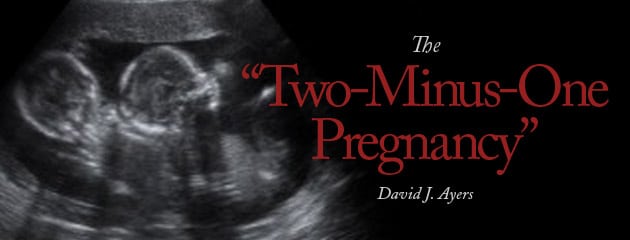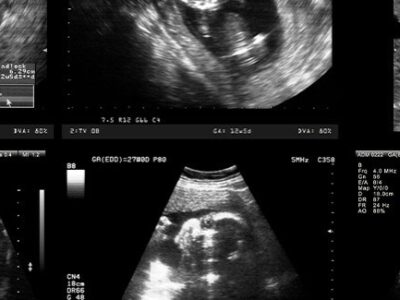
Ever heard of a “two-minus-one pregnancy?” Chances are you have not, unless you have read the recent article by that title in the New York Times Magazine. This expression, which we may have to get used to, is one more “weasel term” in a long list of euphemisms invented by champions of “choice.” It refers to a rare but increasingly used “medical” procedure that some women want and some physicians provide—also known as a “twin reduction.” How does it work?
Well, let’s say a woman is pregnant with twins but only wants one baby. Exercising her constitutional right not to finish any pregnancy unless she chooses, she can have a willing doctor inject potassium chloride into the beating heart of one of the healthy babies. She and the other baby are “safe,” because the physician is carefully guided by sonogram images. (The mother and her partner can watch too, but usually decline.) Since the dead baby is left to shrivel in the womb with the live one until birth, the baby she chooses to keep won’t be killed by its removal.
Most physicians who do “pregnancy reduction” (normally taking large numbers of babies down to two or three) don’t want to do “two-minus-one” procedures. If the patient doesn’t change her mind but wants to stay with the same doctor, she can threaten to abort both babies if the doctor refuses to terminate one. Under this threat the doctor sometimes yields—better one death than two. Some physicians perform the procedure regardless.
Sometimes there are added considerations in “two-minus-one pregnancies.” Women pregnant with fraternal twins of different sexes can use the procedure for sex selection. The author of the Times article reassures us that, since lots of American women actually want girls more (unlike China), we don’t need to worry about a net “gender bias” effect. One woman had the male twin terminated, because she already had a son.
In spite of the fact that most physicians flatly state that there are no valid medical reasons for pregnancy reductions in normal twin pregnancies, doctors willing to perform them have found they can reduce a woman’s guilt by “educating” them on the risks she and her babies may face if she births twins. This may not take all the guilt away, however. So often, to further alleviate their consciences, women electing twin reduction ask their doctors to use some kind of chance procedure to pick the winner and loser, so they don’t have to. In such cases, it is usually the one who unfortunately finds itself closer to the needle.
One problem is what, if anything, to tell surviving twins later. No one knows the psychological consequences. One creative soul who had triplets “reduced” plans to have a discussion with her sole, surviving daughter. She will tell her about the “choices” women now have—a kind of “women’s liberation moment” for the survivor.
So just how did we get “two-minus-one pregnancies” in the first place? It started with an increase in large multiple-birth pregnancies (sextuplets and the like) caused, usually, by fertility treatment. Doctors often recommended, and performed, a lot of “pregnancy reduction” in such cases, but typically refused to do so beyond twins. However, some of these women demanded all but one baby be terminated, and some doctors went along. Meanwhile, those engaged in “pregnancy reduction” kept getting better at it. Soon the procedure was increasingly done on women who were just pregnant with twins in the first place.
So why would women pregnant with twins want to “minus” one? The main reasons cited in the Times article were “social” and “emotional”—not medical. Women want to avoid the stresses and deprivations of raising twins, often even construing their “choice” as an act of love that benefits both the terminated and surviving twin. As one proponent admitted, it is really about women exercising their freedom to “fashion their lives how they want.”
In the 1970s and 1980s, pro-choice activists ridiculed what they claimed were illegitimate “slippery slope” arguments made by pro-lifers about what moral horrors might be generated by an absolute right to abortion. We were told that Roe v. Wade would mainly allow freedom for the “hard choices” of desperate women; those hard choices would become increasingly rare as birth control became more effective and widely available. We now have countless women casually obtaining one abortion after another, and for all sorts of reasons. The newest reason is the “two-minus-one pregnancy.”
The slippery slope is here. And we are picking up speed.




